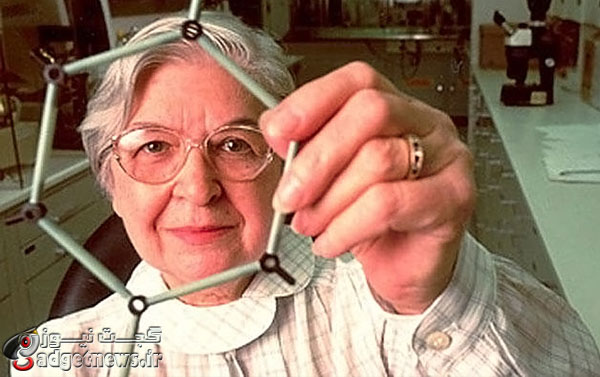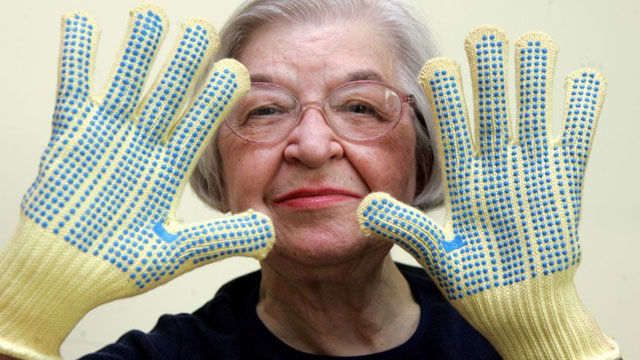
استفانی کولک، شیمیدان و خالق فیبرهای فوق العاده محکم کولار و مشهور (Kevlar) دیروز در سن 90 سالگی درگذشت. رییس شرکت DuPont که کولک در آن فعالیت داشت پس از درگذشت وی در اطلاعیهای نوشت: «بدون شک او زنی پیشرو و نمونه در دنیای علم بود. کمکهای او به دنیای مهندسی و تکنولوژی ای که هماینک نجاتدهنده جان انسانهاست، عامل ماندگاری او در یاد و ذهن ماست.»
هر چند کولار این روزها به واسطه به کارگیری آن در لباسهای ضدگلوله شناخته میشود، اما کولک در ابتدا تنها به دنبال ماده ای سبکتر، محکمتر و همچنان قابل انعطاف به عنوان جایگزینی برای فولاد به کار رفته در تایرها بود.

کولاک سال 1964 در لبراتوار شرکت DuPont در حال تلاش برای اختراع یک فیبر جدید بود و آخرین تلاش او به جای تولید یک ماده سفت و شفاف منتج به تولید یک مایع سبک و غیرشفاف شد! این اتفاق طبیعتا دلسردکننده بود، اما او شروع به تنیدن ماده حاصل به شکل فیبر کرد و به شکل غافلگیرکننده ای متوجه قرارگیری منظم مولکولهای مایع یاد شده در کنار یکدیگر شد. حاصل کار در نهایت تولید یک فیبر فوق العاده محکم بود. فیبر حاصل پنج برابر محکمتر از فولاد و علاوه بر این ضدآتش بود.
امروزه فیبر تولیدی کولاک در هر چیزی که فکر آن را بکنید، کاربرد دارد. از کولهپشتیهای ویژه، دوچرخه و قایق بگیرید تا هواپیما، ماشینهای فرمول وان، لباسهای ضدگلوله و دستکشهای ویژه… روحش شاد.
منبع : bloomberg
Stephanie Kwolek, DuPont Chemist Who Created Kevlar, Dies
Stephanie Kwolek, the DuPont Co. (DD) scientist whose research on polymers in the 1960s led to the creation of Kevlar, the light, super-strong synthetic fabric used in bulletproof vests and body armor credited with saving thousands of lives, has died. She was 90.
Kwolek died on June 18 in the Compassionate Care Hospice Unit at St. Francis Hospital in Wilmington, Delaware, Edward J. Adams, a DuPont spokesman, said in an e-mail.
“We are all saddened at the passing of DuPont scientist Stephanie Kwolek, a creative and determined chemist and a true pioneer for women in science,” DuPont Chief Executive Officer Ellen Kullman said in a statement. “She leaves a wonderful legacy of thousands of lives saved and countless injuries prevented by products made possible by her discovery.”
During an achievement-laden career as a chemist at E.I. duPont de Nemours & Co., Kwolek made her greatest mark with her 1965 work on a liquid crystal polymer that, dissolved in solvent and pressed through a device resembling a very fine colander, became a fiber five times stronger than steel, ounce for ounce.
Patented as Kevlar, it found many industrial applications, most notably protecting soldiers and police officers from bullets and shrapnel. In the 1970s, it was adopted as the preferred material in bullet-resistant vests, replacing earlier alternatives such as nylon, fiberglass and boron carbide. The lives of more than 3,000 U.S. law-enforcement officers have been saved by vests and other body armor since the mid-1970s, according to the National Institute of Justice in Washington.
Lives Saved
“Not in a thousand years did I think the discovery of this liquid solution would save thousands of lives,” Kwolek said in 2003, according to USA Today.
Referring to the widespread use of Kevlar vests and helmets by U.S. forces in Iraq, she added, “When I watch the war on TV, I take great pride in saying, ‘We at DuPont invented that.’”
In a 1998 oral-history interview with the Chemical Heritage Foundation, Kwolek recalled the process that led to the breakthrough.
By 1964, she said, the DuPont lab “had made hundreds of polymers” — materials including nylon and spandex — “and had devised many new ways of making polymers, but there was still one block.” That was the lack of a breakthrough on so-called para-aramids, a type of polymer with rigid, rod-type molecules.
‘Extremely Odd’
After six months of experimenting with solvents on two of the polymers, she came up with an “extremely odd” chemical solution, one that was watery and cloudy rather than the typical viscous and transparent. She said she had to persuade the worker in charge of the lab’s spinneret to give it a try.
“It formed very strong fibers and the stiffness was absolutely spectacular,” Kwolek recalled, according to a 1999 interview with the Pittsburgh Post-Gazette. “That’s when I said ‘Aha.’ I knew then and there it was an important discovery.”
The next challenge, for DuPont, was the material’s commercial application. For almost 15 years following the discovery, DuPont spent $500 million to develop the product, which it called “Fiber B,” at a pilot plant in Richmond, Virginia.
The initial idea was that Kevlar would replace heavier steel in radial tires, making cars more fuel-efficient. A 1974 New York Times article headlined “Kevlar Enters Spotlight as New ‘Miracle Fiber’” mentioned that and other potential uses, such as mooring offshore oil platforms and strengthening yacht sails. No mention was made of its bullet-resistant properties.
Bullet Test
Lester Shubin, a program manager at the U.S. Justice Department’s National Institute of Justice, and Nicholas Montanarelli, a project director at the U.S. Army Land Warfare Laboratory, teamed up to test Kevlar’s capabilities against bullets in 1972. They found that in most cases, the Kevlar vests repelled and deformed the bullets by dissipating their energy through the woven fabric.
In a 1975 field test overseen by Shubin, 5,000 Kevlar vests were distributed to police in large U.S. cities. Three officers shot in the chest, two others repeatedly stabbed and one beaten with a metal-tipped cane escaped serious injury thanks to their vests, according to a government report cited by United Press International in 1978.
In the 1980s, DuPont introduced new varieties of Kevlar for lighter-weight body armor and other uses, such as cut-resistant gloves.
‘More Busy’
Asked in the oral-history interview how it feels to be “a kind of mythical major female inventor,” Kwolek answered with a laugh, “It really hasn’t made any difference for me except that it’s made me more busy. Sometimes I feel sort of embarrassed by the whole thing.”
She was inducted into the National Inventors Hall of Fame in 1995 and received the National Medal of Technology from President Bill Clinton in 1996. She said visiting the White House and other honors meant a great deal in her later years.
“It’s very stimulating, and mentally you don’t have the chance to get old,” she said. “Your body may get old, but your mind doesn’t get old.”
Stephanie Louise Kwolek was born on July 31, 1923, in New Kensington, Pennsylvania, the first of two children. She spent her childhood exploring the woods with her father, John, a foundry worker, according to the 2007 children’s book “Stopping Bullets with a Thread: Stephanie Kwolek and Her Incredible Invention,” by Edwin Brit Wyckoff.
Chemistry Studies
In 1946, she earned a bachelor’s degree in chemistry from the women’s college at Carnegie Institute of Technology, today’s Carnegie Mellon University in Pittsburgh. She applied for a job at DuPont as a temporary measure while she saved money for medical-school tuition.
She started working for DuPont in Buffalo, New York, working under William Hale Charch, who had led the research effort that produced cellophane. She moved to DuPont’s Pioneering Research Laboratory in Wilmington, Delaware, in 1950.
“The only problem was that I became so enamored of the work that I totally lost interest in medical school,” she recalled.
Her earliest work “resulted in hundreds of new polymers, including Kapton polyimide film and Nomex aramid polymer and fiber,” according to the Inventors Hall of Fame, which says her name appears on 17 patents issued between 1961 and her retirement in 1986.
Kwolek had no remaining family, according to the Delaware-based News Journal Media Group.
 گجت نیوز آخرین اخبار تکنولوژی، علم و خودرو
گجت نیوز آخرین اخبار تکنولوژی، علم و خودرو 





